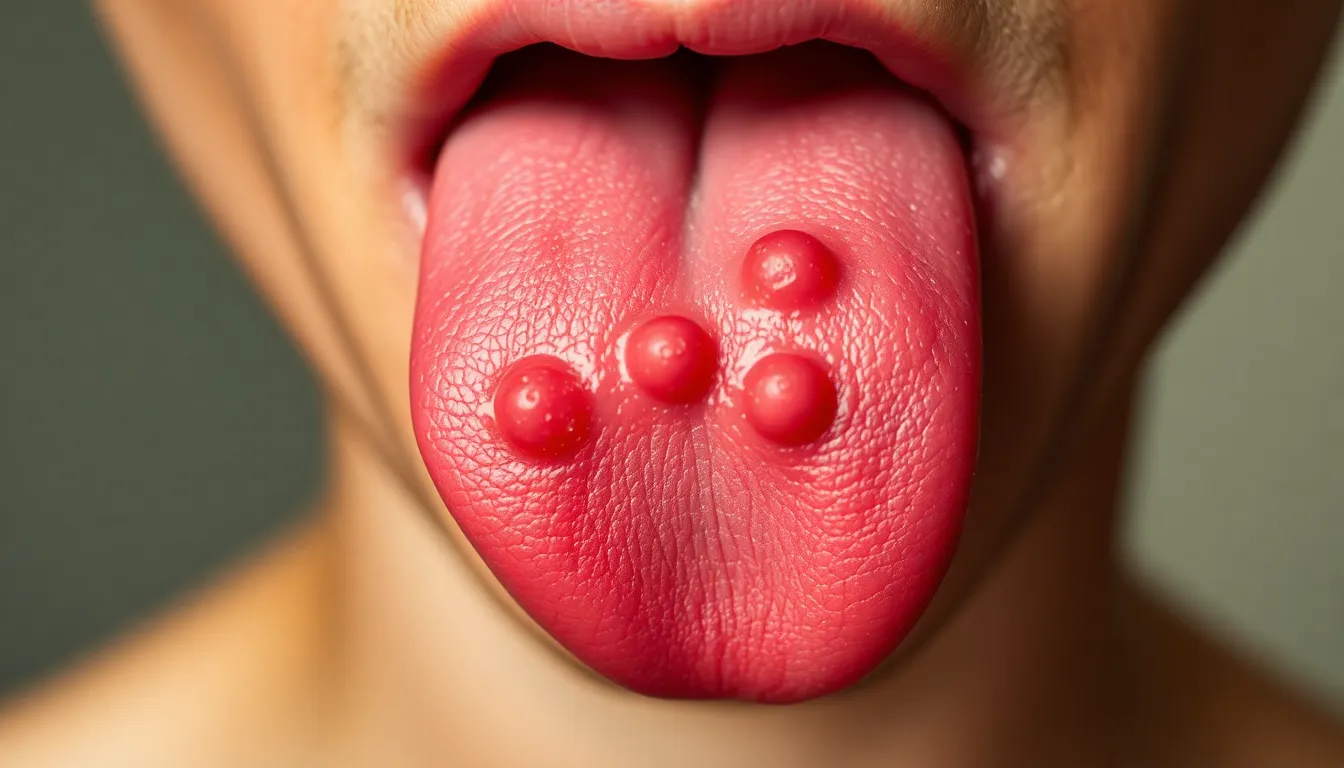Ever felt like you’ve got a little surprise party happening on the bottom of your tongue? That bump might just be the most unwelcome guest you never invited. While it might seem like a minor annoyance, it’s a common concern that can send anyone into a spiral of worry.
Table of Contents
ToggleOverview of Bumps on the Bottom of Tongue
Bumps on the bottom of the tongue can arise due to various causes. These may include irritations, infections, or other medical conditions. Common types of bumps involve lingual papillae, which are normal structures that can become inflamed or enlarged. Occasionally, mucoceles appear as harmless fluid-filled sacs that can develop from blocked salivary glands.
In some cases, viral infections like herpes simplex may contribute to the formation of painful sores or bumps. These issues often cause discomfort but typically resolve without veterinary attention. Similarly, fungal infections, such as oral thrush, may result in a white coated appearance that includes bumps.
Allergic reactions to food or medications can also manifest as bumps on the tongue. Identifying the allergen plays a crucial role in preventing further occurrences. Inflammation from conditions like geographic tongue may create heat and discoloration, resembling bumps, commonly altering the tongue’s texture.
He should monitor the bumps closely. If they persist for over two weeks or worsen, a consultation with a healthcare professional becomes necessary. During the evaluation, the provider may conduct a thorough examination or recommend diagnostic testing to determine the underlying cause. Treatment options vary based on the diagnosis but often include topical medications or lifestyle adjustments.
Understanding these bumps can reduce anxiety about unexpected occurrences. Awareness of symptoms and when to seek help creates a proactive approach to maintaining oral health.
Common Causes

Bumps on the bottom of the tongue can arise from various factors. Here are some common causes.
Viral Infections
Herpes simplex virus often manifests as painful sores on the tongue. This infection leads to blisters that can cause discomfort and irritation. In addition, human papillomavirus (HPV) can result in growths or warts on the tongue. These bumps may require medical evaluation to determine their nature. Other viral infections, such as hand, foot, and mouth disease, can also contribute to bumps on the tongue. Monitoring symptoms is essential, especially if they worsen.
Bacterial Infections
Bacterial infections like oral cellulitis often lead to swelling and painful bumps. Streptococcus bacteria can also cause infections that contribute to lesions on the tongue. Symptoms typically include redness and tenderness in the affected areas. A healthcare provider may prescribe antibiotics to address these infections effectively. Moreover, untreated bacterial infections can lead to more severe oral health issues. Prompt attention can minimize complications associated with these infections.
Allergic Reactions
Allergic reactions to certain foods can appear as bumps on the tongue. Common allergens like nuts, seafood, or dairy can trigger these reactions, causing swelling or irritation. Symptoms may also include itchiness or burning sensations. In some cases, medications can cause similar reactions, leading to bumps as a side effect. Identifying and avoiding allergens is crucial for oral health. Consulting a healthcare professional can provide further insights into appropriate management strategies.
Symptoms to Look Out For
Bumps on the bottom of the tongue often come with noticeable symptoms. Identifying these signs can aid in determining the underlying cause and guiding treatment options.
Pain or Discomfort
Pain often accompanies bumps on the bottom of the tongue. Patients may feel sharp sensations when eating, drinking, or speaking. Discomfort can also arise during contact with certain foods or beverages, particularly spicy or acidic ones. When bumps are caused by infections, the pain may intensify, indicating a need for medical evaluation. Oral thrush and herpes simplex infections, for example, frequently lead to significant soreness. Recognizing increased pain should prompt individuals to seek professional guidance.
Changes in Taste
Changes in taste often occur alongside tongue bumps. Individuals might notice a metallic or altered taste sensation when eating or drinking. This symptom can result from inflammation or infection affecting taste buds on the tongue. Conditions like geographic tongue may produce inconsistent taste experiences as well. Notably, taste changes can indicate deeper health issues that require attention. Persistent alterations in taste should encourage a visit to a healthcare provider for further assessment.
Swelling or Redness
Swelling or redness is another common symptom with bumps on the tongue. Inflammation can manifest as enlarged areas or irregular textures. Observing redness around the bumps may suggest an infection or an allergic reaction. Pay attention to elevated areas as they could indicate serious conditions like oral cellulitis caused by bacteria. Immediate consultation with a healthcare professional is advisable for swelling sufficing concerns. Early treatment can prevent complications and ensure effective healing.
When to See a Doctor
Persistent bumps on the bottom of the tongue warrant a visit to a healthcare professional. If symptoms like pain or discomfort accompany these bumps, seeking medical advice becomes essential. Changes in taste perception or a metallic sensation may indicate underlying health issues that need addressing.
Swelling or redness around the bumps often signifies an infection or allergic reaction. In such cases, immediate consultation helps prevent complications and ensures appropriate treatment. If bumps do not heal within two weeks, a doctor’s evaluation is advisable to rule out serious conditions.
Common signs that necessitate medical attention include difficulty swallowing or breathing. Experiencing these issues signals a potential emergency situation. Additionally, unusual growths that develop rapidly may require further investigation and possibly a biopsy to ensure they are not indicative of a more serious health concern.
If someone notices a white coating on the tongue or persistent sores, these might suggest a fungal infection like oral thrush or viral infections such as herpes simplex. Seeking treatment helps alleviate discomfort and promote healing more effectively. In cases of known allergies, if a bump appears after consuming certain foods or medications, contacting a healthcare provider can clarify the situation and offer relief.
Staying vigilant about changes in the mouth and tongue proves crucial for oral health. Monitoring symptoms and being proactive about consultations enhances overall well-being. Receiving timely care can make a significant difference in health outcomes, making awareness and action vital.
Treatment Options
Various treatment options exist for addressing bumps on the bottom of the tongue. Choosing the right approach depends on the underlying cause.
Home Remedies
Effective home remedies can provide relief for minor bumps. Salt water rinses may reduce inflammation and promote healing. Applying coconut oil creates a protective barrier, preventing irritation. Herbal teas like chamomile or sage can soothe discomfort when consumed warm. Eating soft, bland foods helps avoid irritation while eating. Staying hydrated supports overall oral health, which can speed up recovery.
Medical Treatments
Medical treatments are necessary for persistent or severe bumps. A healthcare professional may prescribe antibiotics to treat bacterial infections that cause swelling. Antiviral medications help manage viral infections like herpes simplex. Allergies might necessitate antihistamines to alleviate discomfort. In cases of abnormal growths, a biopsy may be required to rule out serious conditions. Regular follow-ups ensure effective monitoring and management of ongoing symptoms.
Bumps on the bottom of the tongue can be concerning but understanding their causes is crucial for effective management. Whether they stem from infections, irritations, or allergies, being aware of accompanying symptoms can guide individuals toward timely medical attention. Monitoring changes and seeking professional advice if bumps persist is essential for maintaining oral health.
Taking proactive steps like home remedies can alleviate discomfort, but persistent issues should not be ignored. By staying informed and vigilant, individuals can navigate their oral health with confidence, ensuring any potential problems are addressed promptly.





